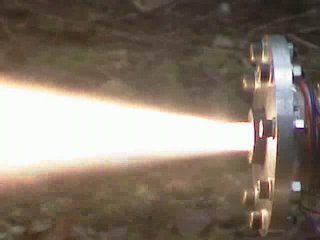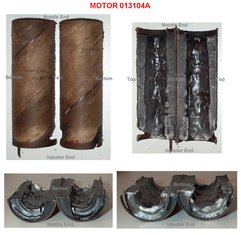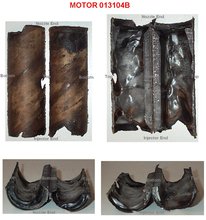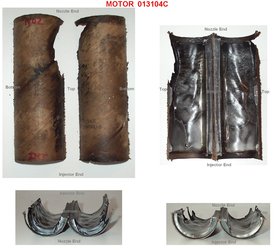Static Test Fire
January 31, 2004
Motor Data
| First Motor | 013104Adata.txt |
| Second Motor | 013104Bdata.txt |
| Third Motor | 013104Cdata.txt |
Fuel Grain Pictures
Raw Video Images
| 1st test - Camera 1 - 3 Second Burn | 013104Aa.mpg |
| 1st test - Camera 2 - 3 Second Burn | 013104Ab.mpg |
| 1st test - Camera 3 - 3 Second Burn | 013104Ac.mpg |
| 2nd test - Camera 1 - 7 Second Burn | 013104Ba.mpg |
| 2nd test - Camera 2 - 7 Second Burn | 013104Bb.mpg |
| 2nd test - Camera 3 - 7 Second Burn | 013104Bc.mpg |
| 3rd test - Camera 1 - 7 Second Burn (no purge) | 013104Ca.mpg |
| 3rd test - Camera 2 - 7 Second Burn (no purge) | 013104Cb.mpg |
| 3rd test - Camera 3 - 7 Second Burn (no purge) | 013104Cc.mpg |
In attendance: Rainer Anacker, Peter Bold, Eim Bold, Tim, Tim's friend, Jim Cloer, Eric Hettinger, Brian O’Neel, Amy O'Neel, Dave Turner, Holly Turner, Jim Ward, Keenan Ward, Mariah Ward, Evan Waymire, Cathy Waymire

Summary
Three gox/paraffin motors were fired today.
The first motor was fired for only three seconds. This was done to verify the new software interface and functioning of the new pneumatic oxygen shut-off assist. All the new systems worked great except for a minor bug in the software that will not allow us to run the test if we inadvertently open two sessions of the control software. The motor itself operate o.k. once it got started but there was a 1 second period at ignition when the burn was not stable (see video).
The second motor was fired for 7 seconds. This burn time was decided upon due to the previous round of testing last month. This second burn verified that 7 seconds is about the maximum we can run the motor before we burn into the cardboard liner, which holds the paraffin. We are concerned that if we operate the motor any longer we may start to compromise the combustion chamber by reducing the yield strength of the 6061 with the elevated temperatures it would experience. The second motor also showed signs of start-up difficulties and had about two seconds of startup instability. The paraffin grain also showed signs of non-uniform erosion similar to all previous test firings.
The third motor was identical to the second test except for we did not purge the motor with nitrogen for five seconds like we did on the first and second motors. This was deliberately done to see if the purge has an effect on the erosion patters we have noticed in the previous tests. The absence of the nitrogen purge did seem to leave a smoother, more uniform, residual paraffin lining post firing. This motor did also have an approximate 2-second burn instability at start-up.
Other Observations
There was still evidence of pooling of paraffin at the bottom of the fuel grain after firing. Less on the first motor fired (3 second burn) and more on the second and third motors fired (7 second burns). The pool is perfectly flat which would suggest it occurred after motor shut down when there was no gas flow to disturb it. It is our hypothesis that there is a fairly significant layer of molten paraffin on the fuel grain walls at motor shutdown and this runs down the sides at motor burnout.
The nozzle that was used was the same for all three motors and was the same nozzle used for the first two tests last month. The nozzle shows very little sign of erosion. Only about a 1.6% enlargement. The only other factors that have changed from the first round of testing that may explain the start-up instability are:
1) Paraffin grain has been extended 3/8" into the premix chamber to reduce the effect of the paraffin immediately regressing to a point that makes the cardboard liner susceptible to burn-through.
2) The ignition ring thickness has been cut in half (from 1/4" to 1/8")
3) The delay time from ignition ring start to oxygen flow initiation has been reduced from 2 seconds to 1 second.
4) The oxygen pressure regulator second stage output has been set at 100psi for both sets of tests but the first set of tests on Dec 31 the tank pressure read about 1500psi where today’s test the pressure of the oxygen tank read 2000psi because we refilled the tank.
What's Next
We are currently working on the new test stand that we will use to collect data such as pressure, force, and regression rate. We will start static firing again once this is complete. We will also investigate the reasons for the start-up instabilities on this round of testing.
Attachments:


